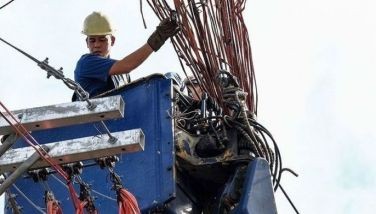Jose Burgos Jr: RP Fourth Estate’s ‘Cincinnatus’
November 23, 2003 | 12:00am
SAN MIGUEL, Bulacan – He could be described as the "Cincinnatus" of sort of the Philippine Fourth Estate.
We once said so, but he humbly refused the comparison.
He preferred to be described as "farmer-journalist" – one who practiced what he wrote and preached.
Yesterday, Joe’s remains were interred in a place on his 12-hectare farm in this town about 90 kilometers northeast of Manila.
He himself had chosen the place where he would be buried – far from the madding crowd that is the Metropolis where he began his career as an investigative reporter in the 1960s.
Fruit trees, notably mango. Forest tree species. Papaya plants. Other foliage. Ricefields. Poultry. A fishpond. A modest farmhouse. A chapel.
An idyllic place, indeed. Reminiscent, to the literarily inclined, of the burial ground which twelfth century Persian poet Omar Khayyam had wished: "My tomb shall be in a place where the northwind scatters roses over it."
So Jose Gacusana Burgos Jr., 62, is gone. And not so few – from President Gloria Macapagal Arroyo to the ordinary media practitioner and man of the farm – traced the highway and country road to his Land Farm which had been his "home sweet home" for the past 15 years.
Nationally and internationally, Vigan, Ilocos Sur-born Burgos had made an indelible mark as a fighting journalist and advocate of press freedom, particularly in the dark years of martial law (declared 1972, lifted in 1981 but continued under "democratic" veil until EDSA I swept to the presidency the widow of Benigno Aquino Jr., Mrs. Corazon C. Aquino).
Much has been written about his feat as a champion of press freedom.
In 2000, he was one of 50 journalists from across the world who were honored by the International Press Institute (IPI) in Boston, USA, as "Press Freedom Heroes".
Fourteen years earlier, he received the "International Journalist of the Year Award-Interpress Service, based at the United Nations in New York.
Further back in 1970, at 29, he was one of the Ten Outstanding Young Men of the Philippines (TOYM), an award he received for his remarkable feat as a reporter of the then Manila Times-Mirror-Taliba publications of the late Don Chino Roces, himself a champion of press freedom.
During the Marcos dictatorship he pioneered in the so-called "alternative press", derisively branded as "mosquito press" by the Marcos administration.
He founded, published, and edited We Forum, Malaya, Midday, and Masa. In 1982, We Forum was shut down by the military and Burgos was detained in Fort Bonifacio.
But not much known about Jose Burgos Jr. is his exemplary record as agriculture, science, and environment writer and broadcaster.
After the EDSA Revolution in 1986, he receded to a farm in San Miguel and engaged in organic farming. To this day, government professionals, researchers, scientists, students, pupils, and farmers visit his farm to observe his environment-friendly farming techniques.
Later, he began writing a column in Filipino on agriculture ("Sa Kabukiran") in the Philippine Daily Inquirer. His column earned for him in 1994 the "Agricultural Journalist of the Year" award by the Philippine Agricultural Journalists, Inc. (PPJ). He was later named an adviser of PAJ, a position he held until the time of his death.
He also went into broadcasting, anchoring a weekly radio program also titled "Sa Kabukiran". The program was adjudged "The Most Outstanding Agricultural Radio Program" in 1996.
In 1998, he won the prestigious "Outstanding Media Award in Science and Technology" sponsored by the Department of Science and Technology (DOST).
He was writing an agricultural column in Today newspaper in 1996 when he was appointed president/publisher and editor-in-chief of the Journal Group of Publications. He later resigned and concentrated on farming and consultancy work.
He had also been honored by the International Rice Research Institute (IRRI) for engaging in another crusade, this time in the fight for freedom against hunger.
In a fitting program held at IRRI, Director General Ronald Cantrell presented the multi-awarded journalist a plaque of appreciation for leading a regional effort to raise awareness of and gain support for rice research and development in Asia through the Asian Rice Media Advocacy Network (ARMAN).
The plaque reads: "His dynamic leadership in ARMAN and in the Rice Media Advocacy Network (Philippines), coupled with his professional relationships among media professionals, has brought about the active and concentrated effort to promote staple food of Asians. His responsible, fair, and balanced reporting has resulted in a better understanding of rice and rice-related issues."
At the time of his demise, Burgos was executive director of the Rice Media Advocacy Network, a group of print and broadcast media practitioners specializing in agriculture reportage.
He authored a book ("Mula Sa Bukid") about agriculture and his experience as a farmer. He also led a work in writing and publishing an agriculture dictionary (English-Filipino).
We once said so, but he humbly refused the comparison.
He preferred to be described as "farmer-journalist" – one who practiced what he wrote and preached.
Yesterday, Joe’s remains were interred in a place on his 12-hectare farm in this town about 90 kilometers northeast of Manila.
He himself had chosen the place where he would be buried – far from the madding crowd that is the Metropolis where he began his career as an investigative reporter in the 1960s.
Fruit trees, notably mango. Forest tree species. Papaya plants. Other foliage. Ricefields. Poultry. A fishpond. A modest farmhouse. A chapel.
An idyllic place, indeed. Reminiscent, to the literarily inclined, of the burial ground which twelfth century Persian poet Omar Khayyam had wished: "My tomb shall be in a place where the northwind scatters roses over it."
So Jose Gacusana Burgos Jr., 62, is gone. And not so few – from President Gloria Macapagal Arroyo to the ordinary media practitioner and man of the farm – traced the highway and country road to his Land Farm which had been his "home sweet home" for the past 15 years.
Nationally and internationally, Vigan, Ilocos Sur-born Burgos had made an indelible mark as a fighting journalist and advocate of press freedom, particularly in the dark years of martial law (declared 1972, lifted in 1981 but continued under "democratic" veil until EDSA I swept to the presidency the widow of Benigno Aquino Jr., Mrs. Corazon C. Aquino).
Much has been written about his feat as a champion of press freedom.
In 2000, he was one of 50 journalists from across the world who were honored by the International Press Institute (IPI) in Boston, USA, as "Press Freedom Heroes".
Fourteen years earlier, he received the "International Journalist of the Year Award-Interpress Service, based at the United Nations in New York.
Further back in 1970, at 29, he was one of the Ten Outstanding Young Men of the Philippines (TOYM), an award he received for his remarkable feat as a reporter of the then Manila Times-Mirror-Taliba publications of the late Don Chino Roces, himself a champion of press freedom.
During the Marcos dictatorship he pioneered in the so-called "alternative press", derisively branded as "mosquito press" by the Marcos administration.
He founded, published, and edited We Forum, Malaya, Midday, and Masa. In 1982, We Forum was shut down by the military and Burgos was detained in Fort Bonifacio.
But not much known about Jose Burgos Jr. is his exemplary record as agriculture, science, and environment writer and broadcaster.
After the EDSA Revolution in 1986, he receded to a farm in San Miguel and engaged in organic farming. To this day, government professionals, researchers, scientists, students, pupils, and farmers visit his farm to observe his environment-friendly farming techniques.
Later, he began writing a column in Filipino on agriculture ("Sa Kabukiran") in the Philippine Daily Inquirer. His column earned for him in 1994 the "Agricultural Journalist of the Year" award by the Philippine Agricultural Journalists, Inc. (PPJ). He was later named an adviser of PAJ, a position he held until the time of his death.
He also went into broadcasting, anchoring a weekly radio program also titled "Sa Kabukiran". The program was adjudged "The Most Outstanding Agricultural Radio Program" in 1996.
In 1998, he won the prestigious "Outstanding Media Award in Science and Technology" sponsored by the Department of Science and Technology (DOST).
He was writing an agricultural column in Today newspaper in 1996 when he was appointed president/publisher and editor-in-chief of the Journal Group of Publications. He later resigned and concentrated on farming and consultancy work.
He had also been honored by the International Rice Research Institute (IRRI) for engaging in another crusade, this time in the fight for freedom against hunger.
In a fitting program held at IRRI, Director General Ronald Cantrell presented the multi-awarded journalist a plaque of appreciation for leading a regional effort to raise awareness of and gain support for rice research and development in Asia through the Asian Rice Media Advocacy Network (ARMAN).
The plaque reads: "His dynamic leadership in ARMAN and in the Rice Media Advocacy Network (Philippines), coupled with his professional relationships among media professionals, has brought about the active and concentrated effort to promote staple food of Asians. His responsible, fair, and balanced reporting has resulted in a better understanding of rice and rice-related issues."
At the time of his demise, Burgos was executive director of the Rice Media Advocacy Network, a group of print and broadcast media practitioners specializing in agriculture reportage.
He authored a book ("Mula Sa Bukid") about agriculture and his experience as a farmer. He also led a work in writing and publishing an agriculture dictionary (English-Filipino).
BrandSpace Articles
<
>
- Latest
- Trending
Trending
Latest
Trending
Latest
Recommended





























